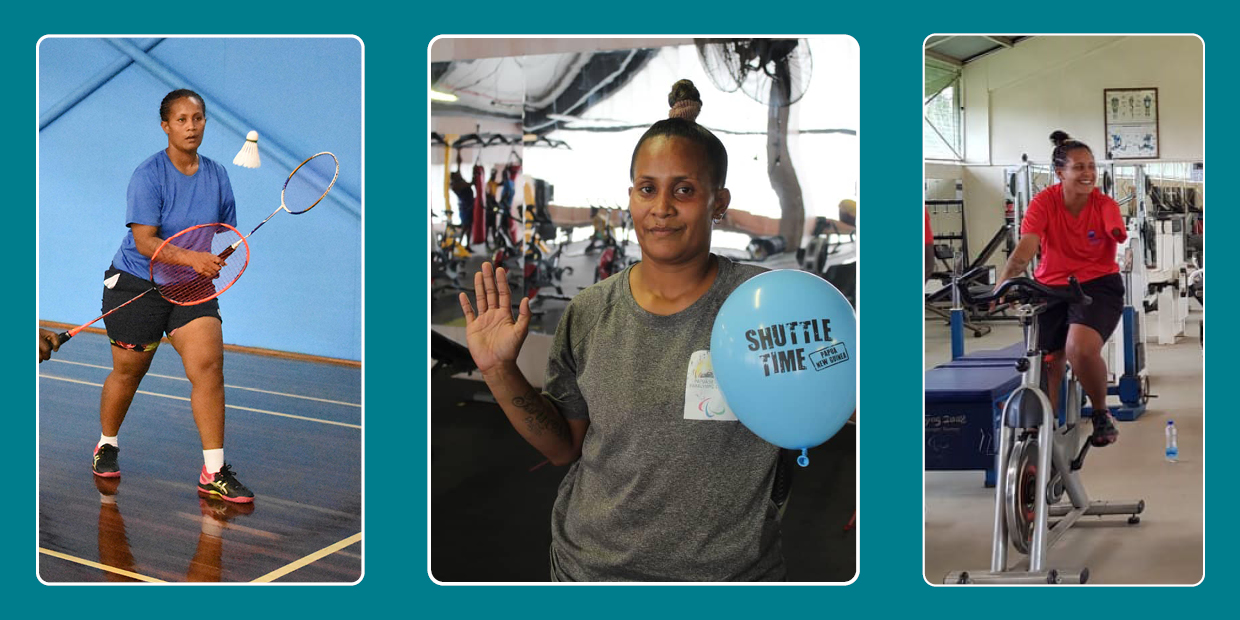Nellie Ruth Leva is an inspirational leader and athlete in Papua New Guinea’s sporting circles. In 2020, she was part of the quadrant which competed in the VICTOR Oceania Para Badminton Championships, becoming PNG’s first athletes to compete in an international badminton tournament. Among them, they collected four medals and continued to inspire a legacy upon their return home.
Firstly, by supporting their association to deliver a food bank project as the global pandemic began to take hold last year. Secondly, by becoming qualified Shuttle Time teachers. Nellie is a regular leader in the Inclusive GymBad – PNG programme, a combined badminton/Shuttle Time and gymnastics session which aims to remove barriers faced by those with disabilities. The initiative is delivered in partnership with Badminton Oceania, Badminton Papua New Guinea, Motivation Australia, Oceania Gymnastics Union, Papua New Guinea Gymnastics and supported by the Australian Government as part of the Team Up programme.
On top of enjoying motherhood for three children, competing in badminton, and delivering Shuttle Time and Inclusive GymBad sessions to her local communities, Nellie is also an avid athletics competitor and has qualified for the javelin event at the Tokyo 2020 Paralympic Games.
She hopes to use her position as a leader and the impending Paralympian status to inspire others.
“For myself as a role model to my community, I hope to inspire and motivate girls and people with disability to gain confidence, pick up a sport and attend the Inclusive GymBad programme”, says Nellie.
Her sporting prowess highlights the benefits of and transferrable skills between different disciplines and sporting codes. In Nellie’s case, she is a left arm amputee and classifies as an SU5 para badminton player, bringing particular attention to the importance of the rotating trunk and left shoulder to assist the overhead technique which is relevant to both badminton and javelin.
Building on a study by Loughborough University which sheds light on the overhead smash, Badminton Oceania reached out to one of the academic contributors and previous international badminton player, Harley Towler, to see how the transferable skills of badminton relate to javelin.
“Research into the badminton smash has identified critical technique factors that also appear in much of the throwing literature. Much of the end-point speed (javelin or racket-head speed) can be attributed to the role of the trunk and shoulder, where being able to counter-rotate your trunk (twisting) more and achieve greater rotational speeds at the trunk and shoulder have been found to be linked to greater shuttlecock speed in the badminton smash.
Of course, some differences do exist. In the badminton smash you are reacting to an incoming projectile, whereas in javelin you are in full control of your run-up and release. Additionally, in the badminton smash you are aiming to generally smash as steep as possible, this often results in a position where the shoulder is elevated and elbow relatively extended to achieve a high contact point. Conversely, in the javelin, the distance thrown is of importance so the release angle will always be above horizontal, and the release height maybe less of an important factor.
The overhead action is used in many different sports such as badminton, tennis, cricket and throwing, with the general aim to maximise release speed, so that either an opponent has less time to react or the projectile is thrown further. With similarities in these examples it is unsurprising that some athletes can perform multiple skills to a high-level by transferring skills from another sport”, says Harley.
Similarly, Fiji’s Iosefo Rakesa is another example of a Para badminton player making waves on the athletics scene. He became Fiji’s first Para badminton representative at the Australia Para Badminton International 2018 and VICTOR Para Badminton Championships 2018, and is also in contention for a medal in the javelin and shot put disciplines in Tokyo.
Para badminton is in its infancy in Oceania, with two continental representatives from Australia (Grant Manzoney and Caitlin Dransfield) competing in Tokyo as the sport makes its debut in the Paralympic Games. We wish all four players the best of luck in Tokyo and look forward to welcoming them all back to a court in the future, along with the next generation who discover the exhilarating potential of Para badminton.
The Tokyo 2020 Paralympic Games get underway on Tuesday 24 August 2021, with the javelin starting on Friday 27 August and Para Badminton starting on Monday 1 September.






